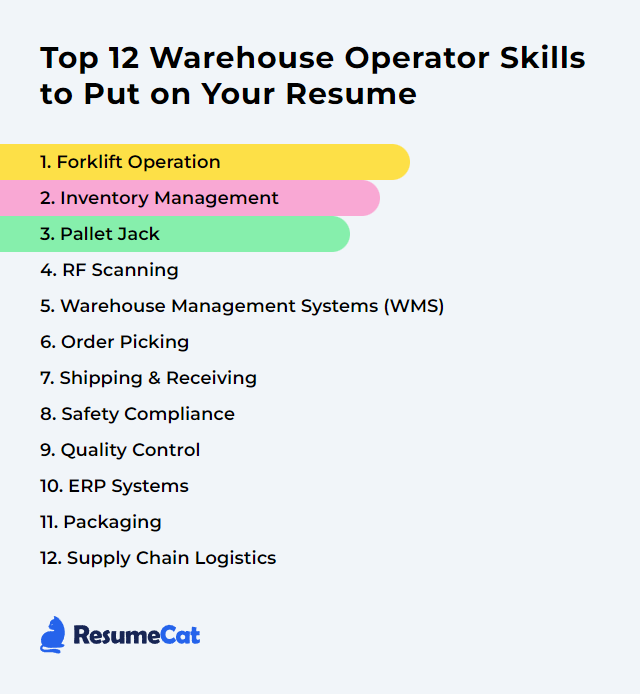Top 12 Warehouse Operator Skills to Put on Your Resume
In today’s crowded hiring arena, a warehouse operator who can show more than lift-and-shift basics gets noticed. A resume that blends technical know-how with sharp execution, safety discipline, and a knack for smooth coordination tells employers you can keep goods flowing, costs lean, and errors scarce in a place where minutes matter and aisles never sleep.
Warehouse Operator Skills
- Forklift Operation
- Inventory Management
- Pallet Jack
- RF Scanning
- Warehouse Management Systems (WMS)
- Order Picking
- Shipping & Receiving
- Safety Compliance
- Quality Control
- ERP Systems
- Packaging
- Supply Chain Logistics
1. Forklift Operation
Forklift operation means steering a powered industrial truck to lift, carry, and stack loads with precision and care, threading through aisles while keeping people, product, and equipment out of harm’s way.
Why It's Important
It speeds up material movement, reduces strain and risk for workers, and allows safe stacking at height, which squeezes more value from every cubic foot of storage.
How to Improve Forklift Operation Skills
Raise the bar on safety and control, and productivity follows:
Training and certification: Complete and refresh OSHA-compliant training; practice in realistic layouts and mixed-traffic conditions.
Pre-shift checks: Inspect brakes, mast, forks, hydraulics, horn, lights, and tires; tag-out immediately if anything’s off.
Safety habits that stick: Seatbelts on, loads within rated capacity, forks low when traveling, eyes up at intersections, horns where sightlines die.
Layout clarity: Clear aisles, marked lanes, one-way routes where possible, mirrors at blind turns, and unambiguous signage.
Telematics and cameras: Use speed limiters, impact sensors, and proximity alerts to catch risky behavior and coach in real time.
Continuous practice: Short refreshers and skills challenges—tight turns, precise placement, mixed load sizes—keep muscle memory sharp.
Do these consistently and incidents drop while throughput tightens up.
How to Display Forklift Operation Skills on Your Resume
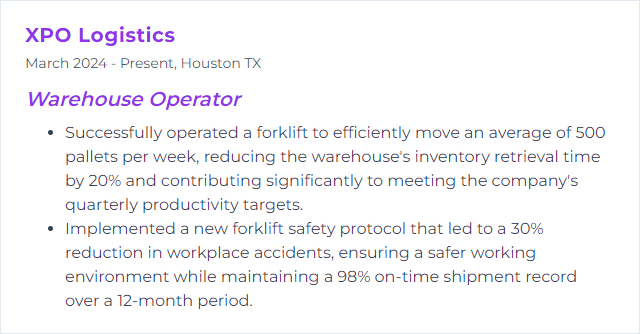
2. Inventory Management
Inventory management is the day-by-day discipline of ordering, receiving, storing, counting, and dispatching goods so the right items are in the right spot at the right time—without bloated stock or empty shelves.
Why It's Important
It protects cash flow, prevents stockouts, trims carrying costs, and keeps promises to customers. Accuracy in the bins becomes confidence at the dock.
How to Improve Inventory Management Skills
Small shifts, big payoff:
Real-time visibility: Use an inventory system that updates on every movement—receipts, picks, transfers, cycle counts—straight from the floor.
Barcode or RFID: Standardize labeling and scanning to slash keying errors and speed counts; align with GS1 standards where possible.
Cycle counting over wall-to-wall: Count high movers often, slow movers periodically, and reconcile variances quickly with root-cause fixes.
Forecast and buffer intelligently: Blend historical demand with seasonality and current lead times; set safety stock and reorder points by item behavior, not guesswork.
Slotting logic: Place fast movers close to pack-out, heavy items lower, families together; use data (and revisit quarterly) to cut walking time.
Lean mindset: Trim dead stock, shorten replenishment loops, and clean up master data that keeps causing hiccups.
Cross-training: Teach pickers to receive, receivers to count, and everyone to audit—knowledge multiplies accuracy.
How to Display Inventory Management Skills on Your Resume
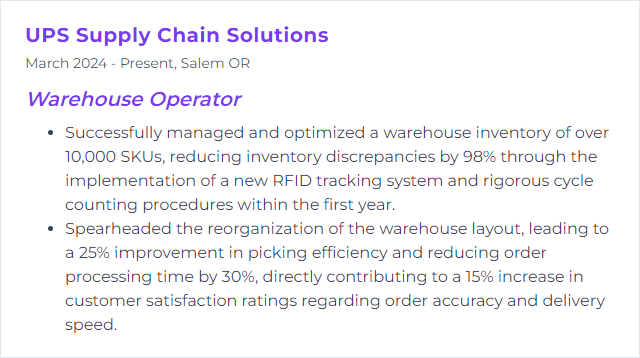
3. Pallet Jack
A pallet jack—manual or powered—lets you lift and whisk pallets across short distances, threading loads into tight corners where larger trucks can’t dance.
Why It's Important
It reduces back-breaking moves, speeds floor-level transport, and keeps operations nimble in cramped lanes or staging areas.
How to Improve Pallet Jack Skills
Keep it smooth, keep it safe:
Daily checks: Wheels, forks, hydraulics, handle return—fix issues before they become downtime or injuries.
Body mechanics: Push rather than pull when possible, keep the load stable, and pivot with feet instead of twisting your back.
Right capacity: Respect weight limits and load balance; stacked too high or too heavy means trouble.
Ergonomic upgrades: Comfortable grips and correct handle height pay dividends over a long shift.
Accessories and stops: Chocks, dock plates, and skid breakers save time and protect floors and product.
Clear paths: Aisles free of debris and drip spots keep rolling resistance low and accidents lower.
How to Display Pallet Jack Skills on Your Resume
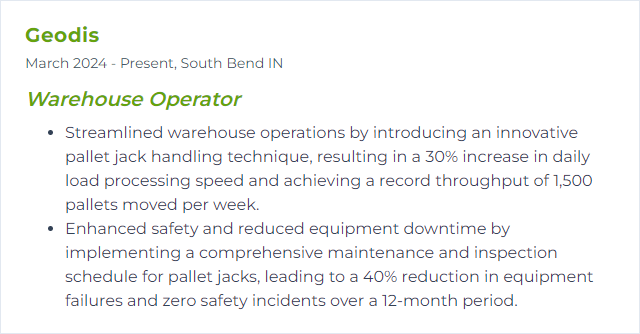
4. RF Scanning
RF scanning uses handhelds or wearables to capture barcodes or RFID, feeding your system instant updates on what moved, where it went, and how many remain.
Why It's Important
It slashes data entry mistakes, tightens pick accuracy, speeds receiving, and makes your inventory truth match what’s on the screen.
How to Improve RF Scanning Skills
Sharpen the tools, then sharpen the habits:
Fit-for-purpose hardware: Rugged devices with strong batteries, quick scanners, and good ergonomics reduce hand strain and downtime.
Clean integration: Tie scanners directly into WMS transactions—no double entry, no lag, fewer surprises.
Label discipline: Consistent label placement and quality printing; damaged or misplaced labels wreck speed.
Workflow design: Fewer taps, clearer prompts, error-checks at the right steps; let the device guide the work.
Training and refreshers: Demonstrate scanning angles, motion, and verification steps; coach on exceptions and damaged codes.
Maintenance loop: Screen protectors, spare batteries, periodic cleaning of optics, and a rapid swap process when devices fail.
How to Display RF Scanning Skills on Your Resume
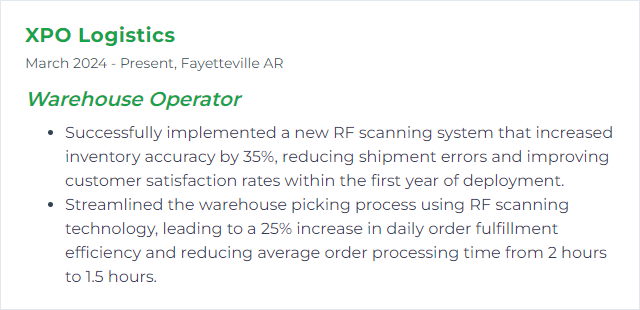
5. Warehouse Management Systems (WMS)
A WMS orchestrates inventory, locations, labor, and orders—directing putaway, picks, replenishments, and packing while keeping a clean ledger of every move.
Why It's Important
It boosts accuracy, trims travel, exposes bottlenecks, and improves on-time shipments. Translation: fewer write-offs, faster turns, happier customers.
How to Improve Warehouse Management Systems (WMS) Skills
Make the system work for the floor, not the other way around:
Smart slotting: Use velocity data to reorganize locations; keep auditing as seasons shift and SKUs change.
Integrate upstream and downstream: Connect to ERP, TMS, ecommerce, and carriers so data doesn’t get stuck in silos.
Automation tie-ins: Feed tasks to conveyors, AMRs, and pick-to-light or voice systems; confirm transactions automatically.
Picking methods that fit: Batch, zone, cluster, wave—or hybrids; choose based on order profiles and labor peaks.
Use dashboards that matter: Track pick accuracy, dock-to-stock time, lines per hour, and aged orders; act fast on outliers.
Governance and updates: Keep master data clean, apply patches, and document processes; short release cycles prevent cruft.
Hands-on training: Floor-level simulations and quick-reference guides reduce errors and raise adoption.
How to Display Warehouse Management Systems (WMS) Skills on Your Resume
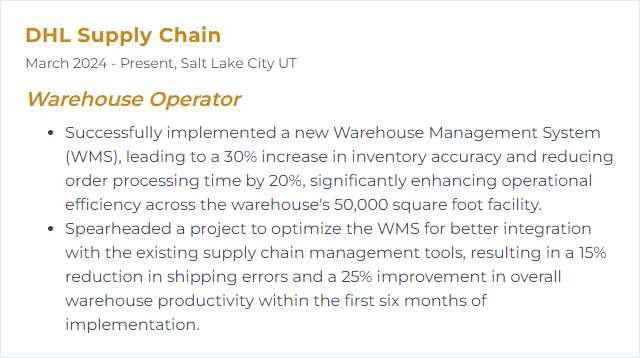
6. Order Picking
Order picking is the hunt-and-gather of warehouse life—selecting the right items in the right quantities and getting them to pack-out intact and on time.
Why It's Important
Pick accuracy and speed ripple everywhere: fewer returns, faster shipping, and a smoother daily pulse across receiving, replenishment, and packing.
How to Improve Order Picking Skills
Trim steps, remove guesswork, and keep hands moving:
Layout for motion: Shorten paths, widen choke points, and place high-velocity SKUs near dispatch; fix the heat map, then fix it again.
Right pick strategy: Single, batch, cluster, or zone depending on order mix; don’t be afraid to switch by time of day.
Guided tech: Use RF, voice, or light guidance; add visual cues and check digits to crush mis-picks.
Ergonomic carts and totes: Reduce reaching and double-handling; standardize container sizes.
Replenish ahead: Top off fast movers during lulls to avoid mid-pick stockouts.
Measure what matters: Picks per hour, first-pass accuracy, and rework rates; coach with data, celebrate clean runs.
How to Display Order Picking Skills on Your Resume
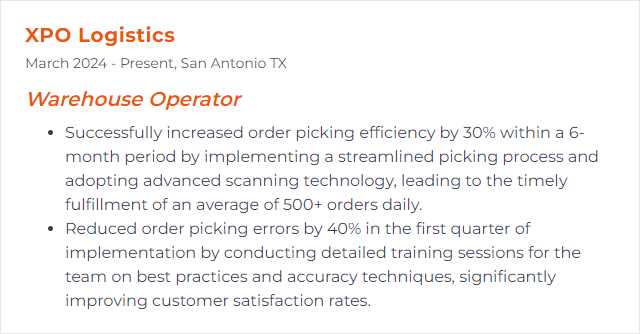
7. Shipping & Receiving
Shipping & Receiving covers everything from dock appointments and inbound checks to labeling, staging, and sealing outbound loads for their next stop.
Why It's Important
It’s the gatekeeper of accuracy and timeliness. Clean receipts and clean ship confirmations prevent mismatches, delays, and chargebacks.
How to Improve Shipping & Receiving Skills
Tighten dock rhythm and information flow:
Clear SOPs: Standardize inbound verification, damage reporting, and labeling; mirror that discipline on the outbound side.
Dock-to-stock speed: Cross-dock fast movers; pre-assign locations before arrivals; use ASN data to prep space and staff.
Scanning at every touch: Receive, stage, load, and confirm with barcodes or RFID; time stamps tell you where the day slipped.
Staging zones: Separate inspected, hold, returns, and ready-to-putaway; confusion evaporates with good signage.
Carrier coordination: Appointment scheduling and live load visibility keep dwell times down.
Safety at the dock: Wheel chocks, dock locks, lights, and communication signals—no shortcuts.
How to Display Shipping & Receiving Skills on Your Resume
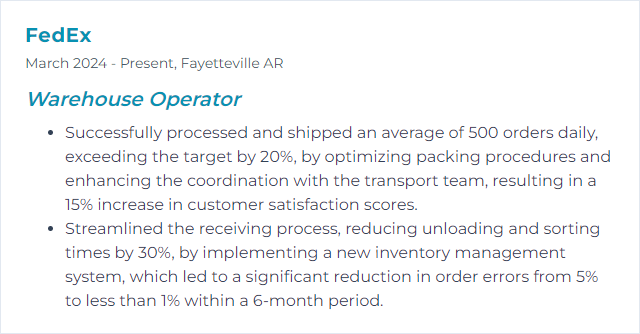
8. Safety Compliance
Safety compliance means following regulations and site rules so everyone goes home uninjured—machines maintained, aisles marked, PPE on, and emergency plans drilled.
Why It's Important
It prevents injuries and property damage, avoids fines, and preserves throughput. A safe warehouse is a faster warehouse.
How to Improve Safety Compliance Skills
Make safety the daily habit, not the poster on the wall:
Hazard identification: Routine walk-throughs, near-miss reporting, and corrective actions tracked to closure.
Train and retrain: OSHA-aligned courses, toolbox talks, and scenario drills—new hires and veterans alike.
Equipment upkeep: PM schedules, lockout/tagout, and documented inspections for forklifts, conveyors, docks, and racking.
Visual controls: Floor markings, speed limits, pedestrian lanes, mirrors, and clear signage where decisions are made.
Emergency readiness: Evacuation routes, spill kits, AED locations, and first-aid coverage—tested regularly.
PPE discipline: Gloves, vests, eye/ear protection, footwear—fit checks and replacements on time.
Engage the crew: Safety committees, quick feedback loops, and recognition when someone stops a job for the right reason.
How to Display Safety Compliance Skills on Your Resume
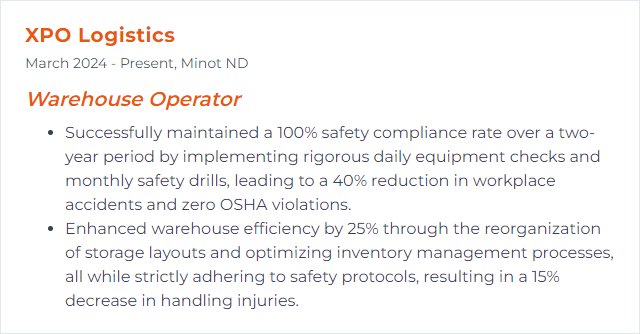
9. Quality Control
Quality Control verifies that what you receive and ship meets spec—correct item, correct quantity, correct condition—before it moves further.
Why It's Important
It kills errors at the source, cuts returns, reduces rework, and keeps customers from losing trust.
How to Improve Quality Control Skills
Precision without paralysis:
Standard work: Document checks for inbound, picking, packing, and loading; use simple checklists at the point of work.
Quality management cadence: Set sampling plans by risk; escalate nonconformances with clear disposition paths (rework, return, scrap).
Root-cause first: When errors pop up, investigate why—the label, the slot, the unit of measure, the training—then fix the process.
Enable with tech: Scan verifications, image capture for damage, and hold codes that actually hold.
Audit rhythm: Internal audits and spot checks; publish results so teams see progress and pressure points.
Feedback loop: Gather input from packers, drivers, and customers; adjust SOPs when patterns emerge.
How to Display Quality Control Skills on Your Resume

10. ERP Systems
ERP systems connect warehouse operations to purchasing, finance, sales, and manufacturing—one source of truth for orders, inventory, costs, and promises.
Why It's Important
It tightens accuracy across departments, speeds decisions, and prevents the classic “our system says we have it” fiasco.
How to Improve ERP Systems Skills
Make the warehouse and ERP speak fluently:
Clean master data: Item units, pack sizes, lead times, and supplier info—garbage in, chaos out.
Floor mobility: Use mobile transactions so workers book moves at the shelf, not hours later at a desk.
IoT signals: Feed temperature, equipment status, and location data into the record for real-world awareness.
Useful reporting: Build dashboards for aged backorders, inventory turns, and past-due receipts; schedule alerts for exceptions.
User training: Role-based instruction with live examples; quick guides for the tasks done 50 times a day.
Governance: Version control for changes, security roles that make sense, and regular updates to keep performance tight.
How to Display ERP Systems Skills on Your Resume
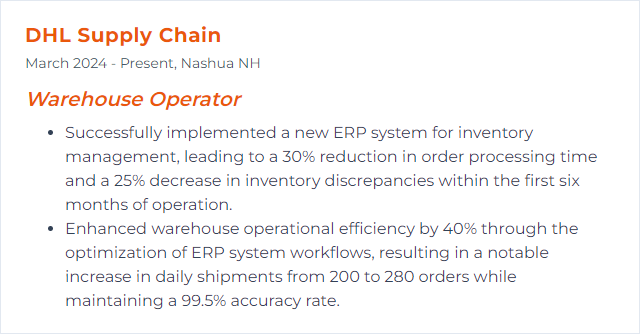
11. Packaging
Packaging prepares product for the bumps, drops, and jolts of storage and transit—right materials, right fit, and labels that speak clearly.
Why It's Important
It protects goods, eases handling, cuts damage claims, and keeps carriers and customers on your side.
How to Improve Packaging Skills
Protect more with less waste:
Fit-to-size: Use cartons that match dimensions; void fill only where it matters; design inserts for fragile items.
Material quality: Durable corrugate, edge protectors, and stretch film that actually stretches—not tears.
Automation where it counts: Case erectors, right-size boxing, print-and-apply labels; let machines handle the repetitive strain.
Clear labeling: Barcodes placed for a single pass, handling icons visible, and carrier-compliant markings.
Sustainability goals: Recyclable inputs, reduced plastics, and standardized sizes to cut waste and freight cube.
Test and learn: Drop tests, vibration tests, and quick feedback from returns to tweak designs.
How to Display Packaging Skills on Your Resume
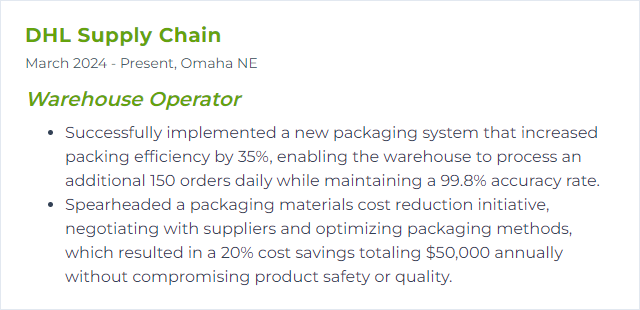
12. Supply Chain Logistics
Supply chain logistics ties storage, transport, and information flow into one rhythm—moving goods from origin to doorstep with the least friction possible.
Why It's Important
Space gets used smarter, trucks leave fuller, costs fall, and customer expectations get met without drama.
How to Improve Supply Chain Logistics Skills
See end-to-end and act locally:
Plan with shared data: Use demand forecasts, supplier lead times, and carrier capacity to align labor, space, and schedules.
Lean inventory: Shorten replenishment cycles, set rational safety stocks, and cut slow-moving clutter.
Layout and flow: Map product paths from dock to rack to pack; remove zigzags and compress touches.
Automation and AMRs: Deploy robotics or conveyors where travel is repetitive; free people for judgment-heavy tasks.
Stronger partnerships: Share forecasts and scorecards with suppliers and carriers; resolve issues before they snowball.
Relentless metrics: OTIF, dock-to-stock, dwell time, damage rate, and cost-to-serve; tune processes against the numbers.
How to Display Supply Chain Logistics Skills on Your Resume

